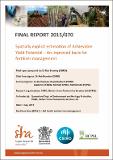| Abstract | Current practice in implementing the SIX EASY STEPS (6ES) is to use the ‘district yield potential’ (DYP) to guide development of nitrogen (N) fertilizer recommendations. However, because both land (soil, topography) and weather/climate may be strongly spatially variable at district scale, yield may also vary rendering use of DYP as sub-optimal. This project explored finer-scale alternatives to DYP as input to 6ES using spatial analysis of mill data and also data collected using yield monitors. The project was focussed in the Herbert River district. Analysis of mill records over 7 seasons shows that there is a marked spatial variability in yield in the Herbert River district, with the patterns of this variation stable across seasons and crop class. Accordingly, we conclude that DYP is not appropriate as an input to 6ES. Rather, a block yield potential derived from a map of the maximum yield of first ratoon achieved over these 7 seasons is suggested as a better alternative; this map, which is derived from interpolated maps of first ratoon yield for each year for which data are available, can be readily updated as more data become available.
Growers with access to yield mapping could readily adopt a similar means of estimating yield potential at the within-farm or within-field scale. However, it is unlikely that sufficient data are yet available to support this given that data from several seasons are needed for yield zone delineation. Whether at the within-region or within-farm or field scales, further location-specific refinement of the application of 6ES is possible with access to data on soil carbon (C) content, whether derived from regional soil survey or local soil testing. Similar analyses to those reported here could be readily conducted in other sugarcane growing regions. Likewise, examination of spatial variation in the other factors underpinning 6ES may also be valuable as the industry seeks to optimise its N use efficiency. |

